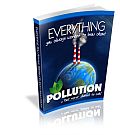Welcome to Pollution Guide
Light Pollution Article

Light Pollution: What's The Bright Idea?
from:The city lights have been a subject of excitement and awe for many. There have been songs written about it and descriptions that describe excitement of the city lights has engaged many people. However, not all is positive with the big city lights. It has been labeled as a form of pollution – light pollution.
Where Does Light Pollution Come From?
Light pollution is not a new form of pollution, but merely a newer recognition. Since the beginning of the Industrial Revolution we have been striving to work longer hours to produce as much as possible. We have been exposed to nighttime activities that require the need of lights, like going out to dinner, seeing a show, strolling the storefronts, and more. Light pollution is described as intrusive light at night.
There are two forms of light pollution. The first is considered to be an annoying light that intrudes on natural or a low light setting. The second is excessive light that is usually used indoors that affects those exposed. Of course the larger cities with dense population have larger amounts of light pollution, but smaller areas and office buildings are sites of such pollution too. A few sources of interior and exterior light pollutants include:
• Building exterior and interior lighting
• Commercial properties
• Advertising
• Offices
• Factories
• Street lighting
• Sporting Venues
Who Could Be Affected?
It seems that some city lights could not do much harm, but perhaps to those who want to stargaze but cannot because the artificial light floods out the natural light of the stars. However, there are many other living beings that are adversely affected by light pollution. Here are some examples:
• Energy Waste – We are always hearing how we should conserve energy, but keep in mind that city lighting is responsible for over ¼ the use of energy and many of it is wasted upward lighting.
• Human Health – Over-exposure to artificial light can cause headaches, fatigue, stress, eyestrain, elevated blood pressure, and even cancer. Artificial light interrupts the natural sleep patterns and release of melatonin, this decrease in melatonin has been directly linked to breast cancer.
• Animals – All life resolves around natural light. Certain organisms have daytime activity and others night. Artificial light can interfere with these natural patterns. Certain algae eaters do not come to the surface to feed on nighttime algae, flight patterns of birds, night blooming flowers that provide food for certain moths, and much more can be affected by the presence of artificial light.
• Improper Placement – Improper lighting can cause unnecessary glare and shadows that may impede drivers and pedestrians.
Light pollution does affect us everyday and it is only until recent studies that we can see what is truly does. It is important for us to realize what the cost of industrialization is doing to our health and for those who are sharing our planet.



